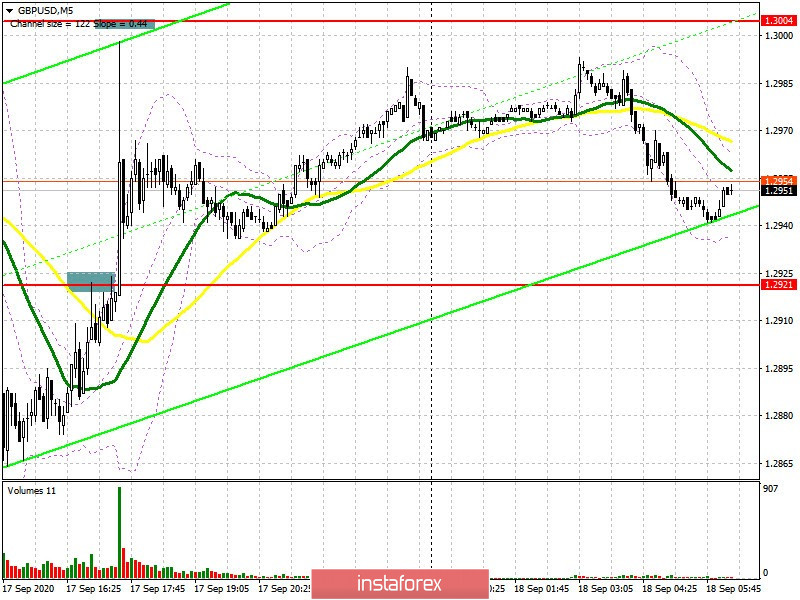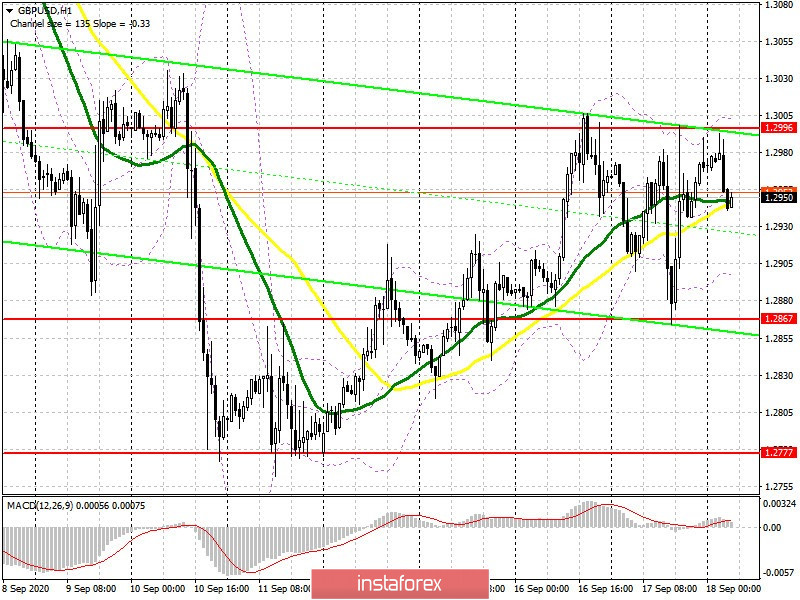To open long positions on GBP/USD, you need:
After some good longs in the British pound, which brought some profit, I paid attention to the likelihood of short positions in my afternoon review after returning and testing resistance at 1.2921 on the opposite side, which happened. On the 5-minute chart, you can see how the bears updated this level, but, unfortunately, the downward movement did not take place, although the entry point was just excellent. It is not entirely clear why the pound sharply grew by almost 80 points in five minutes, but it's what we have. Today, the buyers will focus on the resistance level of 1.2996, and consolidation above this range forms a good entry point into long positions in the hopes of continuing the bull market and updating the high of 1.3089, which is where I recommend taking profits. Persistent bulls will wait for a test of the 1.3178 area, but this is more like a dream, since such a movement requires positive Brexit news. In case the pair falls in the first half of the day, you can count on long positions from support at 1.2867 counting on a correction of 30-40 points within the day.
The Commitment of Traders (COT) reports for September 8 showed that long positions decreased, but there was an even larger drop in short positions, which indicates profit taking after a fairly large bear market that we saw quite recently. This is also evidence that downward momentum in the long term may start to gradually slow down, but much will depend on the terms of the Brexit deal. Short non-commercial positions dropped from 42,901 to 33,860 during the reporting week. Long non-commercial positions fell just slightly, from 49,213 to 46,590. As a result, the non-commercial net position increased to 12,730 against 6,312 weeks earlier.

To open short positions on GBP/USD, you need:
Sellers of the pound need to do everything to prevent the pound from going beyond the weekly high, or else they will completely lose control of the market. Therefore, forming a false breakout at the 1.2996 level will be a signal to open short positions in the hopes of falling towards the support area of 1.2867, which is where I recommend taking profits. Persistent sellers will still be looking for an update to their monthly lows in the 1.2777 area. Testing this level will mark the beginning of a new downward trend for the pair. In case GBP/USD grows in the first half of the day on very bad data on the volume of retail sales in the UK, I recommend postponing short positions and wait until the high of 1.3089 has been updated, where you can sell the pound immediately on a rebound, counting on a 30-40 point correction day.

Indicator signals:
Moving averages
Trading is carried out in the area of 30 and 50 moving averages, and it is difficult to say who will be the winner in the short term.
Note: The period and prices of moving averages are considered by the author on the H1 hourly chart and differs from the general definition of the classic daily moving averages on the daily D1 chart.
Bollinger Bands
A breakout of the lower border of the indicator in the area of 1.2875 will lead to a new wave of decline for the pound. A breakout of the upper border of the indicator in the 1.3000 area will cause the pair to rise.
Description of indicators
- Moving average (moving average, determines the current trend by smoothing out volatility and noise). Period 50. It is marked in yellow on the chart.
- Moving average (moving average, determines the current trend by smoothing out volatility and noise). Period 30. It is marked in green on the chart.
- MACD indicator (Moving Average Convergence/Divergence — convergence/divergence of moving averages) Quick EMA period 12. Slow EMA period to 26. SMA period 9
- Bollinger Bands (Bollinger Bands). Period 20
- Non-commercial speculative traders, such as individual traders, hedge funds, and large institutions that use the futures market for speculative purposes and meet certain requirements.
- Long non-commercial positions represent the total long open position of non-commercial traders.
- Short non-commercial positions represent the total short open position of non-commercial traders.
- Total non-commercial net position is the difference between short and long positions of non-commercial traders.
 English
English 
 Русский
Русский Bahasa Indonesia
Bahasa Indonesia Bahasa Malay
Bahasa Malay ไทย
ไทย Español
Español Deutsch
Deutsch Български
Български Français
Français Tiếng Việt
Tiếng Việt 中文
中文 বাংলা
বাংলা हिन्दी
हिन्दी Čeština
Čeština Українська
Українська Română
Română

